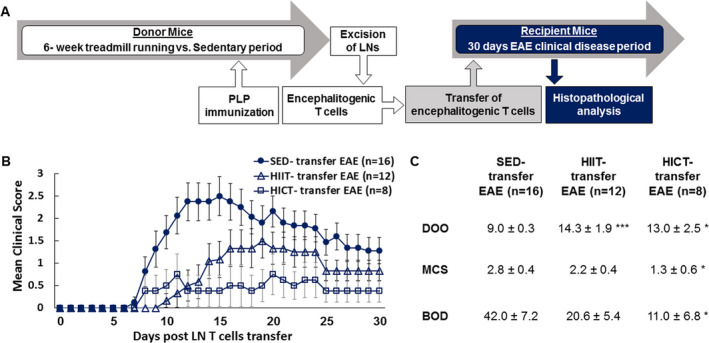Figure 1.

Superior inhibitory effect of high‐intensity continuous training on the encephalitogenicity of lymph node (LN) T cell derived from proteolipid (PLP) ‐ immunized mice in transfer model of experimental autoimmune encephalomyelitis (EAE). (A) Experimental protocol to investigate the effects of exercise training on the systemic immune system in transfer EAE model. Healthy mice were subjected to a 6‐week high‐intensity interval training (HIIT) or high‐intensity continuous training (HICT) treadmill‐running. At the end of the 5th week of training, HIIT, HICT, and sedentary (SED) mice were immunized with a PLP peptide and at the end of the 6th week their lymph nodes (LNs) were removed and stimulated in culture with PLP peptide. Donor HIIT‐, HICT‐, or SED‐ derived encephalitogenic T cells were injected to naïve recipient mice, which developed EAE and were scored daily for neurological symptoms up to 30 days post‐transfer. Mice were sacrificed for central nervous system histopathology analyses 12 days post EAE induction, at the acute phase of disease. Clinical course (B) and clinical parameters (C) of transfer EAE in mice that received PLP‐ reactive LN‐ T cells from high‐intensity interval trained (HIIT‐transfer EAE, n = 12), high‐intensity continuous trained (HICT‐transfer EAE, n = 8) or sedentary (SED‐ transfer EAE, n = 16) mice. The severity of EAE was scored on a 0–6 scale. Transfer of LN‐ T cells derived from both HIIT and HICT, PLP‐immunized mice to naïve recipients induced attenuated EAE, with better effects of HICT on the overall severity of the disease. DOO – day of onset, MCS – maximal clinical score, BOD – burden of disease. Data are mean ± SE. *P < 0.05, **P < 0.01, ***P < 0.001, as compared to SED‐ transfer EAE.
